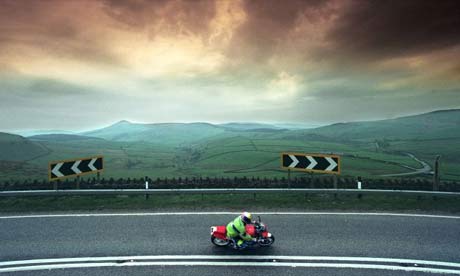I just read @banana29‘s “Emergence of Web3.0” blog on the immediate future of the web. Web3.0, if Alanna is on her game (and I know she is), looks like the next step in managing our data meltdown.
Last year ended with me in a dark and questioning place about the effects of digital media on how people think. I’ve done my due diligence, and read The Shallows by Nick Carr. Carr puts forward a compelling, well researched and accurate account of just what the internet is doing to people in the early 21st Century. I see it in school every day with the digital zombies. What is to become of the poor human too stupid to pass the are-you-human capcha? The Shallows points us to our failure to manage the digital revolution we’ve begun.
I’ve decided to start off the new year by going to the opposite side of the digital Armageddon/digital paradise debate; I’ve just started Ray Kurzweil’s The Singularity Is Near on the advice of a Quora member who describes The Singularity as the opposite of The Shallows. Kurzweil begins the book with some math and an explanation of how exponential growth works. In the process he suggests a different growth pattern than the one most people would intuitively follow.
If Kurzweil is right, and I suspect he is closer than many futurist speculators, then we are about to hit a period of accelerated growth similar to that of the industrial revolution. Our floundering in data is much the same as the mid-nineteenth century’s floundering in early industrialization. Like Dickins, Carr points to the perils of new technology and how it’s making us worse, and there is no doubt that, for the vast majority, it is making them worse at this early stage digitization.
Just as children were pressed into dangerous factory work and pollution killed millions in early industrialization, so our first steps into digitization have zombified much of the populace, making them less than what they were before. Our heavy-handed, pre-digital habits have been hugely amplified by networked efficiencies and have hurt many digital natives in the process. What used to be slow moving, linear marketing in the pre-digital age has become an unending avalanche of brain numbing, tedious attention grabbing on the nascent world wide web.
Sharing music on a mixed tape used to be a benign bit of theft between friends, of no real damage. Take that idea of sharing music and digitize it, and suddenly you’ve crippled a major industry that only existed in the first place because live music was industrialized into sell-able media. Digitization creates efficiencies that would seem completely foreign and unbelievable in previous contexts.
Having friends over to watch a movie, or going out to a movie together that happened before home video, suddenly turns into video sharing online, and stuns another media empire. They struggled against VCRs, then got knocked flat by torrents, but at no point did they think it wasn’t OK to charge me $6 to see Star Wars in the theatre each of nine times, then $40 for the VHS, then another $40 for the DVD, then another $40 for the bluray (it’s not done yet, they’re going to resell it to me in 3D next).
Suddenly police states (like Egypt, Libya or San Francisco) can’t create silence and obedience out of fear, and dictators around the world are faced with a slippery new medium for communication that is not centrally administrated and controlled. Dictators around the world (from media companies to Gaddafi) fear their loss of control over the signal.
We’ve always shared media, we’re a social species and love to share art that represents our stories and culture. Digitization brought that back after a century of industrialized, centralization of culture that trivialized and often eradicated memes that weren’t attractive to enough people. This subtle and persistent destruction of variation culturally bankrupted us by the end of the 20th Century. To many, watching that monster die doesn’t bring on any waves of despair, and will usher in a renaissance of creativity.
Web2.0 pushed social media, allowing common interests and individual ideas to flourish regardless of geography. No matter how trivial or insignificant your interest, you are always able to find a critical mass of people online who you can share your fascination with. This has corrosively weakened the century of industrialized, forced shared interests we’ve all been required to live with.
Digitization is re-animating the idea of a more unique sense of the self. You no longer have to be a brand name junkie based on massive, global industrial interests telling you what you should like. Advertising is agonizing over this now, as are those massive, global interests.
Into this maelstrom of early digitization comes Carr, accurately describing how the early internet is a new medium, infected by the old industrial interests whose heavy handed marketing has created whole generations of attention deficit zombies. When you combine the heavy handed tactics of pre-digital business with the near frictionless and always on nature of digital media, you get a recipe for Ritalin.
Like the soot covered, pollution infected children of the industrial revolution, the screen caged digital child is being treated roughly, but to expect that the early days of a revolution will be like the later days is not historically reasonable; though that shouldn’t stop us from fighting against the dehumanization of children caused by our current mistakes.
Those soot covered child-laborers prompted society to develop public education systems that eventually produced stunning break-throughs in all eras of human endeavor. In fact, that initial failure of industrialization eventually produced a more educated and capable population thanks to the public education it caused. We won’t see soot covered digital children forever.
The digital world we will eventually develop will have as much in common with 2012, as 1970 did with 1870. And if you believe Kurzweil, the exponential growth curve will develop information technology and artificial intelligence so advanced that it begins self-recursion, drastically increasing capabilities. No longer limited to biological evolution, Kurzweil forsees a rate of growth that makes the industrial revolution look positively anemic. It won’t take one hundred years for us to see as much change as industrialization did in a century.
This will happen less soon but more quickly than people suspect, such is the nature of exponential growth. In the process we will be abused by old habits on new technology less and less as more of us become more capable. Web2.0 and social media are a huge step in this direction. We’ll beat back the manipulators and make the technology serve us rather than having economic interests overpowering us with their own heavy handedness.
If this seems like a lost cause, it isn’t; you can’t let something like The Shallows scare you off inevitable change. You’re living in a transformative time, and these are the moments when the people who can see the truth of things to come become architects of the future.
The first motorcycle dream I had was barely remembered, but I woke up pulling hard on the brake with my hand instead of using my foot. I’ve had driving dreams for years, but I can clearly remember that first time I woke up aware of operating a bike in my dreams. I can’t remember the context, but it was nice to know my subconscious was working over the details of riding as much as my conscious mind was.

















